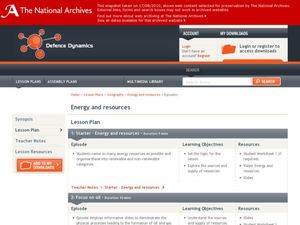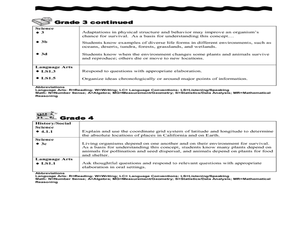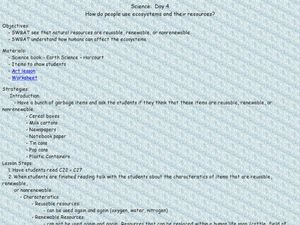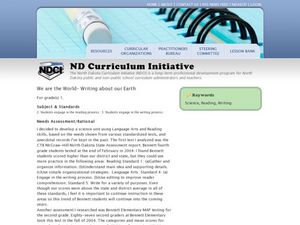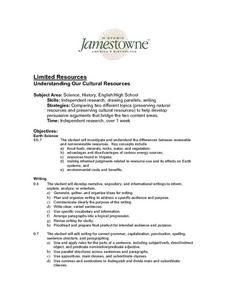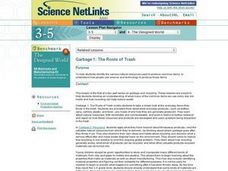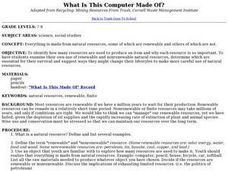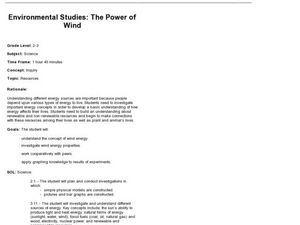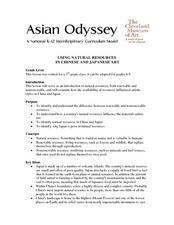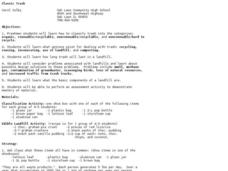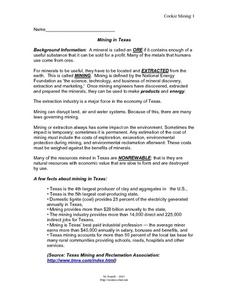Curated OER
Energy and Resources
Students identify renewable and nonrenewable resources. In this energy lesson, students explore the consumption issues regarding oil use and consider methods of resource management. Students research alternative resources and present...
Curated OER
Earth Pockets
Students identify the Earth's natural resources. In this Earth science lesson, students read the book The Great Kapok Tree and discuss types of natural resources. Students use categories such as wood, paper, and trees and list items that...
Curated OER
Wise Use of Our Resources
In this resources worksheet, students will categorize 10 resources as either a renewable or nonrenewable resource. Students will then complete 2 short answer questions.
Curated OER
How do people use ecosystems and their resources?
Learners examine how natural resources are reusable, renewable or nonrenewable. In this ecosystems lesson students see the effects humans have on ecosystems and complete an art lesson activity.
Curated OER
Renewable Resources: Ancient Civilizations
Young scholars examine how ancient people used natural resources. In this renewable resource lesson, students will be put into 5 groups each focusing on a different past civilization. Each group will identify they types of resources...
Curated OER
How Can Resources Be Conserved?
In this resources worksheet, students will list problems associated with using natural resources. Then students will come up with possible solutions for conserving those resources. This worksheet is a graphic organizer.
Curated OER
We are the World - Writing about our Earth
First graders write facts about the Earth. In this Earth instructional activity, 1st graders discuss natural resources, recycling, and how to keep the Earth clean. They work in groups to create a small book with 3-5 facts about the...
Curated OER
Limited Resources - Understanding Our Cultural Resources
Young scholars examine and compare preserving natural resources and preserving cultural resources. They conduct Internet research on two topics, and write a position paper on whether cultural resources or natural resources are more...
Curated OER
Air Pollution
Students seek solutions to environmental problems. They discover how to conserve and protect natural resources. They examine the role of acid rain on plants and discover how to filter pollutants.
Curated OER
GARBAGE 1: THE ROOTS OF TRASH
Students identify the various natural resources used to produce common items; to explain how people use science and technology to produce those items.
Curated OER
What Is This Computer Made Of?
Students identify how many resources are used to produce an item and why each resource is so important. They examine their own use of renewable and nonrenewable natural resources.
Curated OER
Energy Source Puzzles
Students identify renewable and nonrenewable resources. For this energy source lesson, students participate in a game to identify the various types of resources. There are various extensions to this lesson, such as tic-tac-toe and memory...
Curated OER
Renewable and Nonrenewable Resources
Students identify renewable and nonrenewable resources. In this earth science instructional activity, students construct a T-chart of renewable and nonrenewable resources.
Curated OER
Resources
In this resources worksheet, students review renewable and nonrenewable resources. Students also review how resources can be conserved. This worksheet has 7 terms in a crossword puzzle, 3 true or false, and 10 short answer questions.
Curated OER
Environmental Studies: The Power of Wind
Investigate the prospect of wind as a renewable resource. Second and third graders make a pinwheel, answer critical thinking questions, and then attempt to use wind power to wind string. I would be more apt to use this lesson in a 1st or...
Curated OER
Looking at Landforms-Based on the Washington Quarter Reverse
Learners use a Washington State Quarter to examine different landforms and discuss natural resources. After a class discussion on the items found on a Washington State quarter, students brainstorm a list of natural resources found in...
Curated OER
It Won't Last Forever
Learners investigate the recycling process. In this recycling lesson, students set up a classroom program for recycling and set up recycling bins in various areas of the school. Learners investigate other options to reduce waste.
Curated OER
Using Natural Resources In Chinese And Japanese Art
Students discuss the uses and availability of natural resources in China and Japan and how those resources effected visual art from each country. This lesson includes two possible enrichment activities.
Curated OER
Rainforest Resources
Learners explore products of the rainforest. In this environmental stewardship instructional activity, students discover the resources that the rainforest holds and examine products from the rainforest used around the world.
Curated OER
Natural Cleaners
Students explore natural cleaners. For this science lesson plan, students gain an understanding of the effects that commercial cleaners have on the environment and teach them to make their own cleaners out of less hazardous materials.
Curated OER
Classic Trash
Students investigate how trash is classified and the options to deal with it. In this trash and recycling lesson, students perform an activity to classify trash into organic, renewable/ recyclable, now renewable/recyclable and...
Curated OER
Mining in Texas
In this mining and nonrenewable resources worksheet, students read about mining in Texas and simulate the extraction of nonrenewable minerals. They use cookies and their components to represent the minerals they will mine and they answer...
Curated OER
Earth Kids: Kindergarteners Taking Care of the Earth
Students explore a variety of ways of how to care for the environment in the nine lessons of this unit. They observe how to be responsible "Earth Kids."
Curated OER
Environmental Science/Water Pollution
Students study natural habitats, aquatic life, renewable and non-renewable resources. They discuss conservation efforts for sea otters and desert toad in this units.


